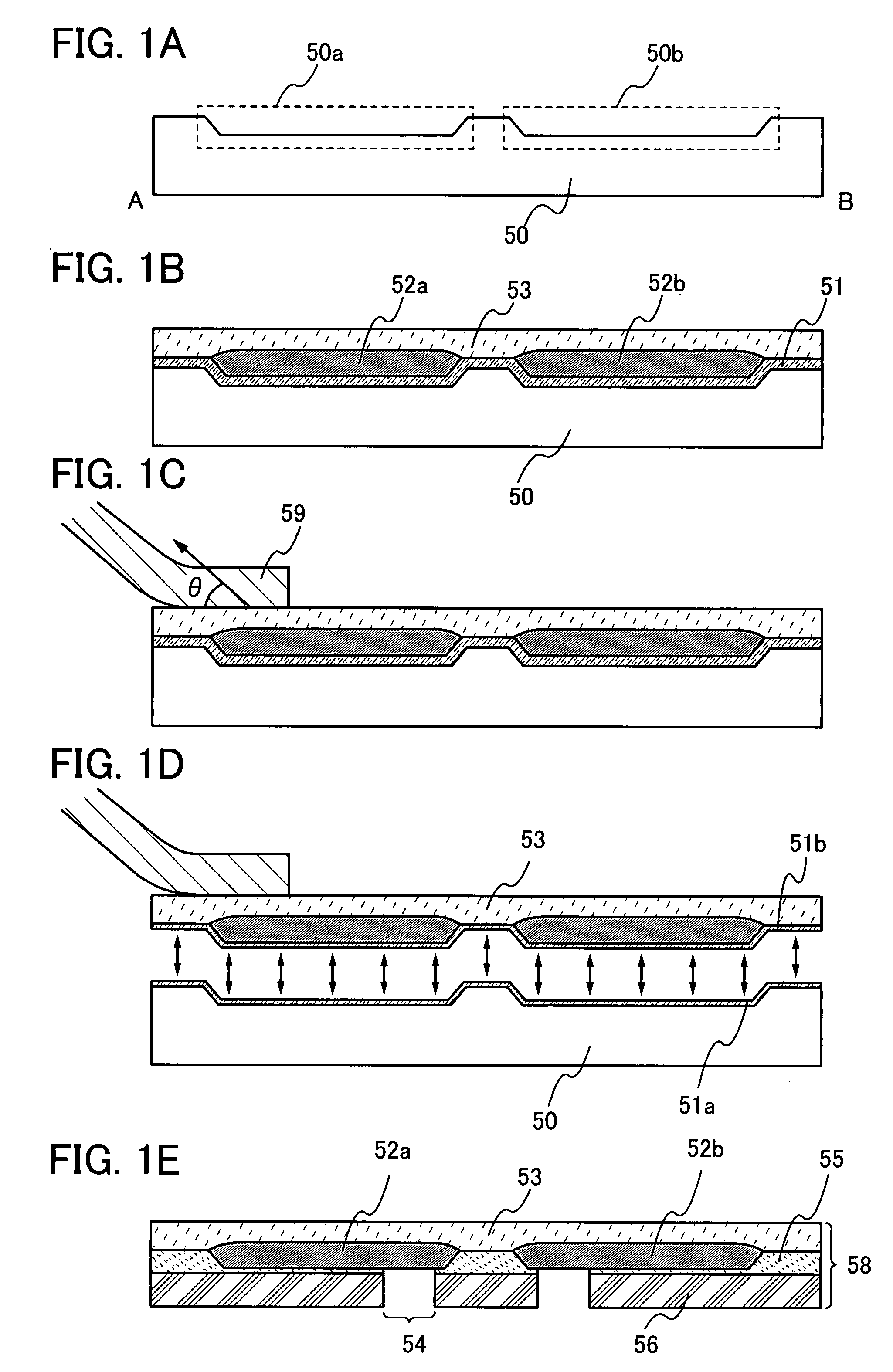Method for forming conductive layer and substrate having the same, and method for manufacturing semiconductor device
- Summary
- Abstract
- Description
- Claims
- Application Information
AI Technical Summary
Benefits of technology
Problems solved by technology
Method used
Image
Examples
embodiment mode 1
[0049] In this embodiment mode, one mode of a method for easily forming a conductive layer is described with reference to FIGS. 1A to 1E, FIG. 5, and FIGS. 12A and 12B. FIGS. 1A to 1E show cross-sectional views of a step of forming a conductive layer. FIG. 5 shows a top view of FIG. 1A. A cross-sectional view taken along a line A-B of FIG. 1A corresponds to a region A-B of a top view of FIG. 5. The conductive layer here serves as an antenna. In addition, a pixel electrode, a wiring, an electrode, and the like can be used as an application of a conductive layer, instead of an antenna.
[0050] As shown in FIG. 1A, a substrate 50 having depressed portions 50a and 50b is prepared.
[0051] As the substrate 50, a substrate having heat resistance against a baking temperature of conductive layers 52a and 52b is preferably used. Typically, a glass substrate, a quartz substrate, a ceramic substrate, a metal substrate, a silicon wafer, an organic resin layer, or the like can be used.
[0052] As t...
embodiment mode 2
[0095] In this embodiment mode, one mode of a method for easily forming a conductive layer is described with reference to FIGS. 2A to 2E. FIGS. 2A to 2E show cross-sectional views of a step of forming a conductive layer.
[0096] As shown in FIG. 2A, a substrate 60 having a flat surface is prepared, and a surface of the substrate 60 is selectively treated, so that depressed portions 62a and 62b as shown in FIG. 2B are formed.
[0097] As the substrate 60, a substrate having heat resistance against a baking temperature of conductive layers 52a and 52b is preferably used. Typically, a glass substrate, a quartz substrate, a ceramic substrate, a metal substrate, a silicon wafer, an organic resin substrate, or the like can be used.
[0098] As treatment by which the depressed portions 62a and 62b are formed in the substrate, laser light irradiation, cutting, etching of a substrate using a resist mask formed in a photolithography step, or the like can be given. In a case where the substrate is ...
embodiment mode 3
[0104] In this embodiment mode, a method for forming a conductive layer that can reduce variation in resistance in different conductive layers is described with reference to FIGS. 3A to 3D. Here, Embodiment Mode 1 is used for the description; however, Embodiment Mode 2 can also be applied.
[0105] As shown in FIG. 3A, in the same manner as in Embodiment Mode 1, over a substrate 50 having depressed portions, a layer 51 in which oxygen and silicon are bonded and an inactive group is bonded to the silicon is formed using a silane coupling agent. Compositions 70a and 70b are applied in depressed portions 50a and 50b over the layer 51 in which oxygen and silicon are bonded and an inactive group is bonded to the silicon.
[0106] Next, portions of the compositions that are higher than a surface of the layer 51 in which oxygen and silicon are bonded and an inactive group is bonded to the silicon are removed to flatten a surface. Alternatively, a region in the compositions 70a and 70b where a ...
PUM
 Login to View More
Login to View More Abstract
Description
Claims
Application Information
 Login to View More
Login to View More - R&D
- Intellectual Property
- Life Sciences
- Materials
- Tech Scout
- Unparalleled Data Quality
- Higher Quality Content
- 60% Fewer Hallucinations
Browse by: Latest US Patents, China's latest patents, Technical Efficacy Thesaurus, Application Domain, Technology Topic, Popular Technical Reports.
© 2025 PatSnap. All rights reserved.Legal|Privacy policy|Modern Slavery Act Transparency Statement|Sitemap|About US| Contact US: help@patsnap.com



